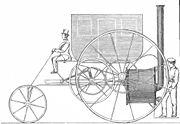
Andrew Vivian
Encyclopedia


United Kingdom
The United Kingdom of Great Britain and Northern IrelandIn the United Kingdom and Dependencies, other languages have been officially recognised as legitimate autochthonous languages under the European Charter for Regional or Minority Languages...
mechanical engineer, inventor, and mine captain of the Dolcoath mine
Dolcoath mine
Dolcoath mine was a copper and tin mine in Camborne, Cornwall, in the United Kingdom. Its name derives from the Cornish for 'Old Ground', and it was also affectionately known as The Queen of Cornish Mines. The site is north-west of Carn Brea. Dolcoath Road runs between the A3047 road and Chapel Hill...
in Cornwall
Cornwall
Cornwall is a unitary authority and ceremonial county of England, within the United Kingdom. It is bordered to the north and west by the Celtic Sea, to the south by the English Channel, and to the east by the county of Devon, over the River Tamar. Cornwall has a population of , and covers an area of...
, England.
In partnership with his cousin Richard Trevithick
Richard Trevithick
Richard Trevithick was a British inventor and mining engineer from Cornwall. His most significant success was the high pressure steam engine and he also built the first full-scale working railway steam locomotive...
, the inventor of "high pressure" steam engine
Steam engine
A steam engine is a heat engine that performs mechanical work using steam as its working fluid.Steam engines are external combustion engines, where the working fluid is separate from the combustion products. Non-combustion heat sources such as solar power, nuclear power or geothermal energy may be...
s, and the entrepreneur Davis Giddy
Davies Gilbert
Davies Gilbert FRS was a British engineer, author, and politician. He was elected to the Royal Society on 17 November 1791 and served as President of the Royal Society from 1827 to 1830....
, Vivian financed the production of the first steam carriage and was granted a joint patent for high pressure engines for stationary and locomotive use in March 1802.
History
In 1801 Trevithick completed his first full-sized road locomotive in CamborneCamborne
Camborne is a town and civil parish in west Cornwall, England, United Kingdom. It is at the western edge of a conurbation comprising Camborne, Pool and Redruth....
, demonstrating it to the public on Christmas Eve with Vivian at the controls. The first day it ran about the streets and up the very steep Beacon Hill. The next day it went down to the village of Crane so that Vivian's family, who lived there, might see it. In a further trial, one week later, the machine overturned in a rut. It was dragged into a shed while Trevithick and Vivian had lunch at a nearby inn; on their return the boiler had run dry, setting fire to the machine's timber frame.
A second locomotive was tried in Camborne and, at the beginning of 1803, in London
London
London is the capital city of :England and the :United Kingdom, the largest metropolitan area in the United Kingdom, and the largest urban zone in the European Union by most measures. Located on the River Thames, London has been a major settlement for two millennia, its history going back to its...
. It was shipped to London in the Little Catherine, a temporary packet commanded by John Vivian (1784-1871), nephew of Andrew Vivian. In August 1803, Mr. Felton, of Leather Lane, London, was paid for building the coachwork. William West assembled the machine, under the supervision of Trevithick and Vivian. It ran successfully, although receiving surprisingly little lasting public attention, but again the state of the road surfaces of the time put paid to the enterprise: the carriage was put out of action with a twisted frame. In the face of this setback Vivian withdrew from the partnership.

